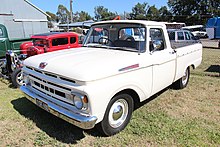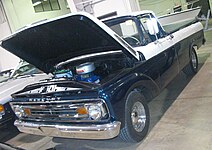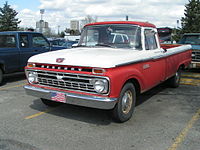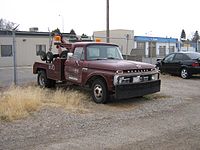|
Ford F-Series (fourth generation)
The fourth generation of the Ford F-Series is a line of trucks produced by Ford from the 1961 to 1966 model years. Introducing a lower and wider cab over the previous generation, Ford introduced several design changes to the model line. In line with modern pickup trucks, the bed sides, hood line, and window sill were all the same height. Ford returned the F-Series to two headlights (a design change that remained in place for over 50 years). Several design configurations were introduced by this generation. The F-Series panel van was discontinued (replaced by the Ford Econoline) and Ford introduced the "integrated pickup" for 1961.[3] In line with the car-based Ford Ranchero, the Styleside configuration welded the cab and bed body stampings together (removing the gap between the two).[3] After 1963, "integrated pickups" were no more.[3] For 1965, the model line underwent a substantial revision, introducing chassis and cab that would be used by the F-Series through 1979. Alongside the debut of the four-door crew cab configuration, the long-running "Twin I-Beam" independent front suspension and 300 cubic-inch inline-6 were both introduced.[4] Taken from the defunct Edsel brand, the Ford Ranger nameplate made its first appearance. The model line was assembled by Ford across multiple facilities across the United States, Canada, and Mexico; the model line was also assembled by Ford Argentina. In Canada, the F-Series was again sold as the Mercury M-Series. Model history1960–1962 Along with the traditional separate Flareside beds, Ford introduced unibody trucks. These were originally named as the "integrated pickup" and consisted of the cab and the bed into one continuous piece, with no gap between them.[3] The design required fewer stampings, such as the back of the cab served as the leading edge of the bed, less complicated assembly, such as the single-wall bed sides were spot-welded directly to the door sills, and the body had a less complicated path through the assembly plant's paint shop.[3] This achieved cost savings in the manufacture of the truck, but the one-piece cab and bed body was still mounted to a traditional ladder frame chassis.[3] Only two-wheel-drive F-100 and F-250 models used this one-piece construction—four-wheel-drive models and all F-350s, as well as all models with Flareside beds, continued to use separate cabs and beds. Styleside beds were carried over from the 1957–60 models. 1962–1964Due to poor market reception, and rumors that overloading caused the doors to jam shut, the unibody trucks were dropped midway through the 1963 model year. The 1961/64 models have the turn signals in the grill. 1964 models received an all-new Styleside bed with more modern styling as well as a longer wheelbase on two-wheel-drive trucks while short beds and 4x4 retained the earlier wheelbases. 1965–1966In October 1964, the 1965 F-Series introduced an all-new frame, which would be used on the F-Series through 1979. The body itself remained largely unchanged, but on 1965 and 1966 models the turn signals are above the headlights. Replacing the rudimentary straight-axle in the front was all-new independent "Twin I-Beam" suspension with coil springs on two-wheel-drive trucks.[4] The change in suspension also lengthened wheelbases slightly. 1965 and 1966 F-Series trucks are distinguished with a "TWIN I-BEAM" emblem on the front fender. A 4-door crew cab was also introduced on F-250 and F-350 models. The 240 cu in (3.9 L) and 300 cu in (4.9 L) straight six was introduced. With the introduction of the 208 hp (155 kW; 211 PS) 352 cu in (5.8 L) FE V8, output surpassed 200 hp in the F-Series for the first time. Argentinian-made 1961–1968First vehicles were made in the old plant of La Boca, in the Ciudad Autónoma de Buenos Aires. Starting in 1962, production was moved to General Pacheco, partido de Tigre (30 to the north). Using the Y-block and Diesel Perkins engines (like the 6-305 and 6-354), the F-100 (1/2 ton pickup model),[5] F-350 (1 ton truck model),[6] F-500 (4 ton truck model)[7] and F-600 (5 ton truck)[8] until 1968, when Ford Argentina launch the "punta de diamante" series. Mexican assembly 1965–1966New automotive assembly regulations and laws favoring domestic manufacture over imports were decreed by the Mexican government in 1962. After decades of Ford trucks built in Mexico from imported assembly kits, 1965 was first Mexican-built Ford truck in the recently-open Cuautitlán Assembly in Cuautitlán Izcalli. The models included the F-100 (1/2 ton pickup model), F-350 (1 ton truck model) and F-600 (5 ton truck). The F-100 came in two versions: a chassis cab and pickup truck with a like-Ford F-Series third generation bed). The trucks were fitted with the 289 cu in (4.7 L) V8 engine that was introduced in the Mexican market of Ford pickups and medium-duty trucks, producing 160 hp (119 kW; 162 PS) at 4,000 RPM. These engines were also used in the Ford Mustang that was also manufactured in the Cuautitlán Assembly in Mexico. Models
A Camper Special was available featuring heavier-duty components to accommodate the slide in campers that were becoming increasingly popular during this time. For 1965, the Ranger name first appeared as a styling package for the F-Series pickup trucks. The interior featured bucket seats and a curtain over the gas tank which was behind the seats in the cab.[9]
Powertrain
References
|
||||||||||||||||||||||||||||||||||||||||||||||||||||||||||||||||







